Martha Novelly (1889-1972) was a German stage and screen actress who peaked in the German silent film of the late 1910s.
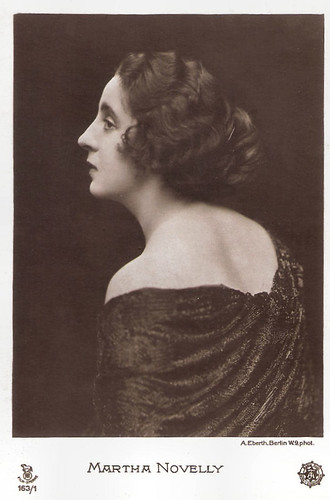
German postcard in the Film-Sterne series by Rotophot, no. 163/1. Photo: A. Eberth, Berlin / Astra Film.
Martha Novelly was born Martha Buchholz in Hamburg, Germany, in 1889.
At age 15, she debuted on the stage in 1904 in Lübeck. Afterwards she acted in Flensburg, Oldenburg, Frankfurt (Oder), Chemnitz, Nürnberg and Stuttgart. From 1914 she performed in Berlin at the Lustspielhaus.
Just like many of her fellow stage actors in Berlin, she started a film acting career during the First World War. Her first part was that of Edith, one of the general’s daughters in General von Berning (Heinrich Bolten-Baeckers, 1914), starring Albert Paul, Aranka Keller, Leo Peukert and Ernst Hofmann. About the same time Novelly also played with again Paul, Keller and Hofmann in Bolten-Baeckers’ Um Liebe und Ehre/To love and honour (Heinrich Bolten-Baeckers, 1914).
Novelly was absent from the film set in 1915. Then she had the female lead in the Harry Piel adventure film Unter heisser Zone/Under Hot Zone (1916), with Mogens Enger, Preben Rist and Viktor Janson. The story dealt with a captain (Enger) hunting for a precious South-African diamond, stolen by a Dutch swindler (Rist) and his American accomplice (Novelly). Shots were taken in Berlin, the Hamburg Zoo and aboard the ship Kaiserin Auguste Viktoria.
Until the end of the First World War, Unter heisser Zone was Harry Piel ’s most ambitious production. It announced his post-war specialisation of adventure films with wild animals. The film contained several spectacular scenes, including a lion hunt, a car falling into an abyss, the explosion of a kettle, a chase on a ship, and an explosion of a bridge just before a luxury train arrives, causing only the locomotive to drop down.

German postcard by Verlag Hermann Leiser, Berlin. Photo: Atelier Eberth, Berlin.
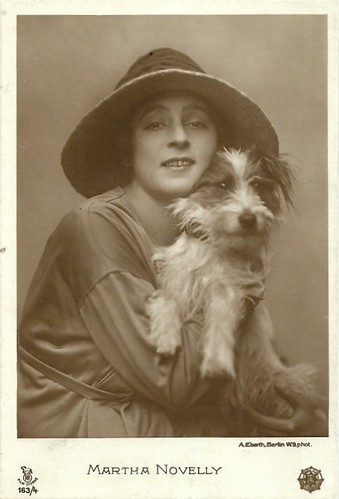
German postcard in the Film-Sterne series by Rotophot, no. 163/4. Photo: Atelier Eberth, Berlin / Astra Film.
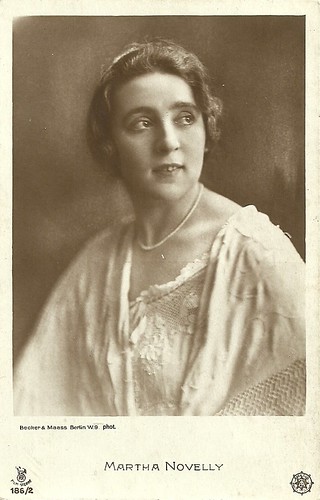
German postcard in the Film-Sterne series by Rotophot, no. 186/2. Photo: Becker & Maass, Berlin / Astra Film.
Between 1916 and 1918 Martha Novelly was a leading film actress in serious, dramatic films. From 1917 she acted as star in several dramas of the Astra Film company, directed by Emerich Hanus, including Unheilbar/Incurable (1917) with small parts for Emil Jannings and Werner Krauss, Das Gewissen des Andern/The conscience of others (1917) with Bruno Decarli, Bruno Kastner and Theodor Loos, and E – der scharlachrote Buchstabe/E - the scarlet letter (1918) with Werner Krauss.
In Die Sühne/Atonement (Emmerich Hanus, 1917), Renate (Novelly) and Ludwig (Kurt Vespermann), who have been friends already in childhood, fall in love with each other. When Ludwig is blinded by accident, Renate takes care of him. She becomes a sculptress and opens a studio in his house. Ludwig starts to flirt with a model, the dancer Sibylle (Lore Rückert). When a doctor restores his sight, he is appalled by Renate’s loss of beauty and chases the dancer, until he finds out she is only after his money. Clearly Ludwig, needs to be cured of his spiritual blindness as well. A print of the film was found back at the EYE Film Institute Netherlands and restored in Germany.
In Die Liebe der Maria Bonde/The Love of Maria Bonde (Emmerich Hanus, 1918), Novelly is Maria Bonde, the middle sister of family of three daughters. The eldest daughter Gunne (Eva Maria Hartmann) is betrothed to Martin, a circus rider (Emerich Hanus) with whom she acts together. He instead prefers Maria, declares her his love when she substitutes for Gunne in the circus. He elopes with her, causing the death of Gunne. When Maria has a child and cannot perform, it is now her youngest sister Anella (Ursula Hell) to substitute her in the circus. Will Martin dump Maria now? Maria has visions of her deceased sister warning her, and of her mother catching her and Martin kissing.
A few years after her marriage in 1918, Martha Novelly ended her short film career. Her films of 1919 were for the company Deutsche Bioscop: Flitter-Dörtje/Bauble Dortje (Robert Leffler, 1919) with Charles Willy Kaiser and Rudolf Klein-Rogge, and Die Geige des Tommaso/The violin of Tommaso (Emerich Hanus, 1919).
Novelly’s last films were Cagliostros Totenhand/Cagliostro's dead hand (Nils Olaf Chrisander, 1919) with Eugen Klöpfer, and the French production Irène (Marcel Dumont, 1920) starring Louise Colliney as Irène and Marcel Vibert.
Martha Novelly died in 1972 in Berlin.
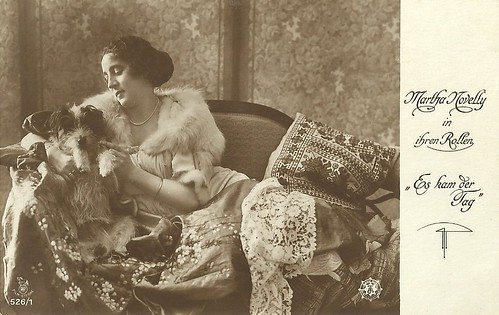
German postcard in the Film Sterne series by Rotophot, no. 526/1. Photo: Astra-Film. Publicity still for Es kam der Tag (1918).
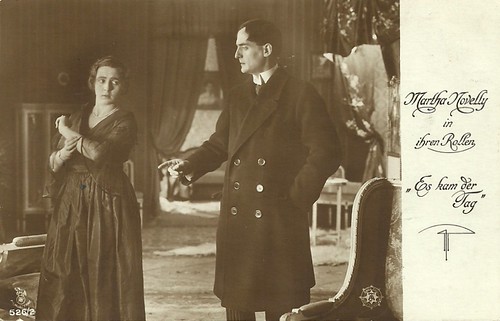
German postcard in the Film Sterne series by Rotophot, no. 526/2. Photo: Astra-Film. Publicity still for Es kam der Tag (1918).
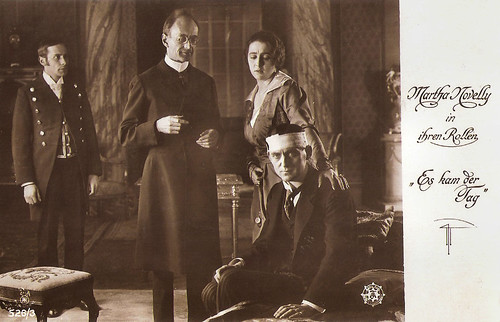
German postcard in the Film Sterne series by Rotophot, no. 526/3. Photo: Astra-Film. Publicity still for Es kam der Tag (1918).
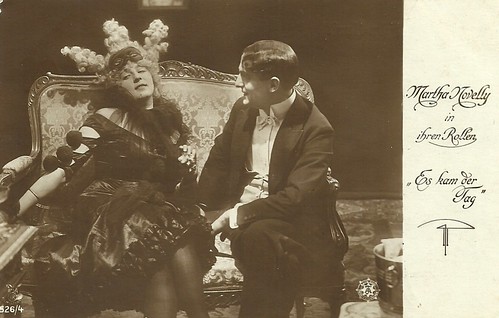
German postcard in the Film Sterne series by Rotophot, no. 526/4. Photo: Astra-Film. Publicity still for Es kam der Tag (1918).
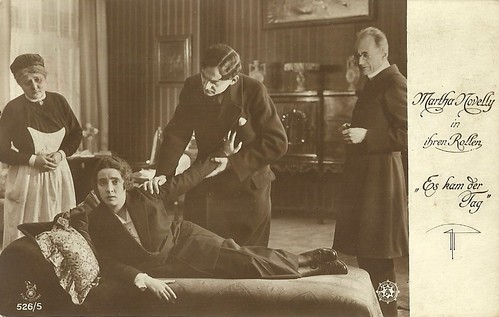
German postcard in the Film Sterne series by Rotophot, no. 526/5. Photo: Astra-Film. Publicity still for Es kam der Tag (1918).
Sources: Rot für Gefahr, Feuer und Liebe (German), Filmportal. de, The German Early Cinema Database, Wikipedia (German), and IMDb. For Die Liebe der Maria Bonde, see European film gateway.

German postcard in the Film-Sterne series by Rotophot, no. 163/1. Photo: A. Eberth, Berlin / Astra Film.
Several spectacular scenes
Martha Novelly was born Martha Buchholz in Hamburg, Germany, in 1889.
At age 15, she debuted on the stage in 1904 in Lübeck. Afterwards she acted in Flensburg, Oldenburg, Frankfurt (Oder), Chemnitz, Nürnberg and Stuttgart. From 1914 she performed in Berlin at the Lustspielhaus.
Just like many of her fellow stage actors in Berlin, she started a film acting career during the First World War. Her first part was that of Edith, one of the general’s daughters in General von Berning (Heinrich Bolten-Baeckers, 1914), starring Albert Paul, Aranka Keller, Leo Peukert and Ernst Hofmann. About the same time Novelly also played with again Paul, Keller and Hofmann in Bolten-Baeckers’ Um Liebe und Ehre/To love and honour (Heinrich Bolten-Baeckers, 1914).
Novelly was absent from the film set in 1915. Then she had the female lead in the Harry Piel adventure film Unter heisser Zone/Under Hot Zone (1916), with Mogens Enger, Preben Rist and Viktor Janson. The story dealt with a captain (Enger) hunting for a precious South-African diamond, stolen by a Dutch swindler (Rist) and his American accomplice (Novelly). Shots were taken in Berlin, the Hamburg Zoo and aboard the ship Kaiserin Auguste Viktoria.
Until the end of the First World War, Unter heisser Zone was Harry Piel ’s most ambitious production. It announced his post-war specialisation of adventure films with wild animals. The film contained several spectacular scenes, including a lion hunt, a car falling into an abyss, the explosion of a kettle, a chase on a ship, and an explosion of a bridge just before a luxury train arrives, causing only the locomotive to drop down.

German postcard by Verlag Hermann Leiser, Berlin. Photo: Atelier Eberth, Berlin.

German postcard in the Film-Sterne series by Rotophot, no. 163/4. Photo: Atelier Eberth, Berlin / Astra Film.

German postcard in the Film-Sterne series by Rotophot, no. 186/2. Photo: Becker & Maass, Berlin / Astra Film.
Serious dramatic films
Between 1916 and 1918 Martha Novelly was a leading film actress in serious, dramatic films. From 1917 she acted as star in several dramas of the Astra Film company, directed by Emerich Hanus, including Unheilbar/Incurable (1917) with small parts for Emil Jannings and Werner Krauss, Das Gewissen des Andern/The conscience of others (1917) with Bruno Decarli, Bruno Kastner and Theodor Loos, and E – der scharlachrote Buchstabe/E - the scarlet letter (1918) with Werner Krauss.
In Die Sühne/Atonement (Emmerich Hanus, 1917), Renate (Novelly) and Ludwig (Kurt Vespermann), who have been friends already in childhood, fall in love with each other. When Ludwig is blinded by accident, Renate takes care of him. She becomes a sculptress and opens a studio in his house. Ludwig starts to flirt with a model, the dancer Sibylle (Lore Rückert). When a doctor restores his sight, he is appalled by Renate’s loss of beauty and chases the dancer, until he finds out she is only after his money. Clearly Ludwig, needs to be cured of his spiritual blindness as well. A print of the film was found back at the EYE Film Institute Netherlands and restored in Germany.
In Die Liebe der Maria Bonde/The Love of Maria Bonde (Emmerich Hanus, 1918), Novelly is Maria Bonde, the middle sister of family of three daughters. The eldest daughter Gunne (Eva Maria Hartmann) is betrothed to Martin, a circus rider (Emerich Hanus) with whom she acts together. He instead prefers Maria, declares her his love when she substitutes for Gunne in the circus. He elopes with her, causing the death of Gunne. When Maria has a child and cannot perform, it is now her youngest sister Anella (Ursula Hell) to substitute her in the circus. Will Martin dump Maria now? Maria has visions of her deceased sister warning her, and of her mother catching her and Martin kissing.
A few years after her marriage in 1918, Martha Novelly ended her short film career. Her films of 1919 were for the company Deutsche Bioscop: Flitter-Dörtje/Bauble Dortje (Robert Leffler, 1919) with Charles Willy Kaiser and Rudolf Klein-Rogge, and Die Geige des Tommaso/The violin of Tommaso (Emerich Hanus, 1919).
Novelly’s last films were Cagliostros Totenhand/Cagliostro's dead hand (Nils Olaf Chrisander, 1919) with Eugen Klöpfer, and the French production Irène (Marcel Dumont, 1920) starring Louise Colliney as Irène and Marcel Vibert.
Martha Novelly died in 1972 in Berlin.

German postcard in the Film Sterne series by Rotophot, no. 526/1. Photo: Astra-Film. Publicity still for Es kam der Tag (1918).

German postcard in the Film Sterne series by Rotophot, no. 526/2. Photo: Astra-Film. Publicity still for Es kam der Tag (1918).

German postcard in the Film Sterne series by Rotophot, no. 526/3. Photo: Astra-Film. Publicity still for Es kam der Tag (1918).

German postcard in the Film Sterne series by Rotophot, no. 526/4. Photo: Astra-Film. Publicity still for Es kam der Tag (1918).

German postcard in the Film Sterne series by Rotophot, no. 526/5. Photo: Astra-Film. Publicity still for Es kam der Tag (1918).
Sources: Rot für Gefahr, Feuer und Liebe (German), Filmportal. de, The German Early Cinema Database, Wikipedia (German), and IMDb. For Die Liebe der Maria Bonde, see European film gateway.
No comments:
Post a Comment